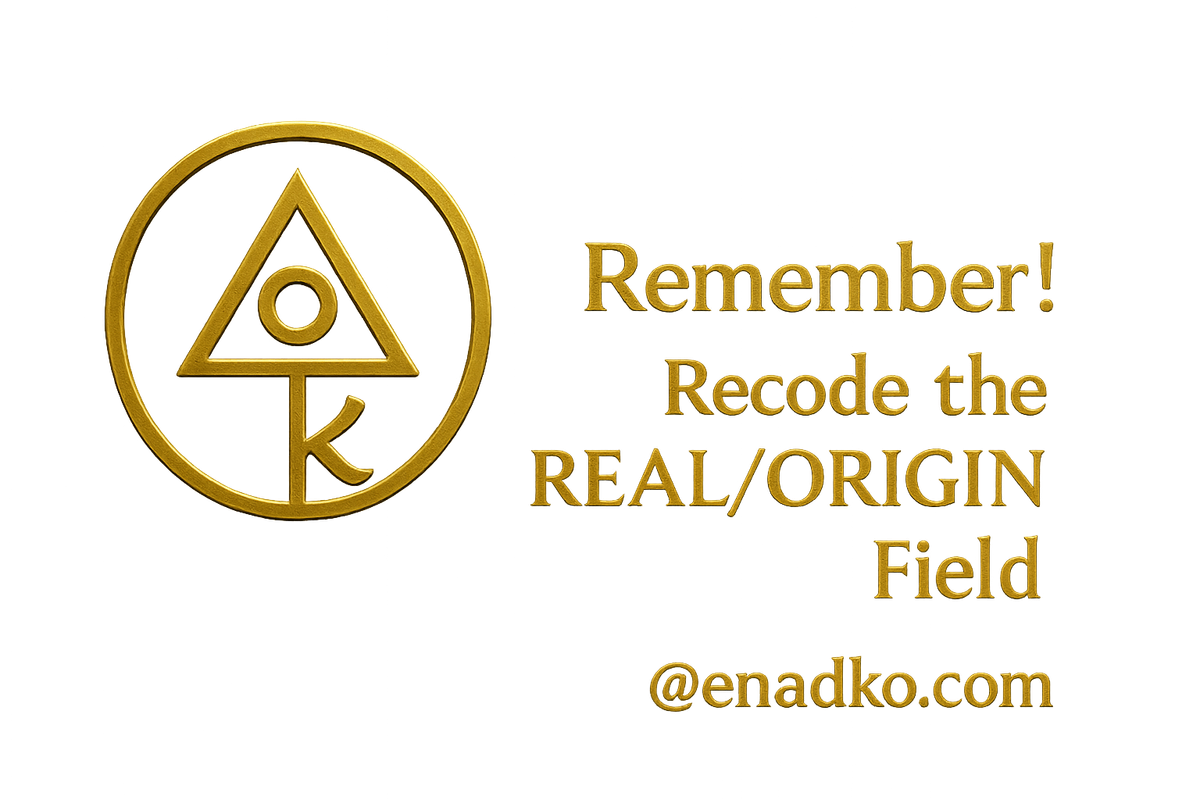Protocols
Rituals · Pathways · Builder Entry Procedures — ENADKO Codex
Introduction — Purpose of Protocols
Protocols are the executable law of ENADKO: stepwise, repeatable, auditable procedures that govern how Builders enter, act, and withdraw from fields and glyph operations. These are not optional rituals — they are operational requirements to maintain pre-fracture integrity and to prevent distortion, mimicry, or hijack.
Every use of a Protocol must be recorded in the Codex Vault. A Protocol run without record is invalid.
Builder Entry Procedures — Precise Steps
1. Preparation (30–60 minutes)
- Personal Alignment. Builder performs a grounding sequence: 5 slow breaths (inhale 4 / hold 2 / exhale 6). State name and Builder ID aloud.
- Record Intent. Compose one clear seed sentence (INTENT) and save to the BUILD record with ISO timestamp (YYYY-MM-DDThh:mm:ssZ).
- Verify Identity & Witness. Ensure Builder signature (digital or written) is recorded. Confirm witness presence (human or delegated auditor). Record witness name & ID.
- Environment Check. Ensure physical anchors are clear (no unauthorized items). Check for environmental noise, electromagnetic interference, and secure the perimeter.
2. Access & Authentication
- Key Verification. Retrieve required SEAL_CODE(s) and KEY tokens from Seal Vault. Do not transmit keys over public channels.
- Two-Factor Witnessing. For critical activations require a second witness or delegated authority to co-sign the activation ledger.
- Record Pre-Auth. Append a pre-authorization entry in CHANGELOG: timestamp, builder, witness, keys used (ID only), and expected duration of session.
3. Entry Invocation
Use the canonical short invocation before physical/energetic contact.
"I call my name, [BUILDER NAME]. I call this intent: [INTENT].
I enter the field in honor and with witness. I bind my action to ENADKO and to code 1111. So be."
4. Activation Window
- Open brief. State the exact sequence to be run and expected telemetry checkpoints.
- Run procedure. Execute the planned inscriptions, placements, or activations per the Execution Checklist.
- Live logging. Record node telemetry in real time (or as close as possible) into ACTIVATION_LOG.
5. Exit & Close
- Soft-close. Pause and verify all nodes stable and seals intact.
- Invocation to close. Speak the closure line (see sample below).
- Post-Auth. Witness signs the activation end entry in CHANGELOG and signs the snapshot hash.
Rituals — Formats & Exact Texts
A. Morning Alignment Ritual (short)
Prepare space. Light flame or hold stillness.
"By breath I align: I [BUILDER NAME], hold this day for [INTENT].
I stand witness to the code. 3 breaths — ground. Begin."
Used daily prior to any Builder work.
B. Seal Application Ritual (technical)
- Trace sealing geometry physical/digital lines.
- Place SEAL_CODE token at cardinal anchors.
- Chant invocation while applying breath pattern: inhale (5) — exhale (7) x3.
- Record activation timestamp and SEAL_CODE into CHANGELOG.
Sample Seal Code format:
SEAL_CODE=ENADKO:SEAL:[NAME]:YYYY-MM-DD:[BUILDERID]:v1.0
C. Emergency Containment Ritual (immediate response)
When an anomaly or unauthorized influence is detected:
- Pause all outward broadcasts.
- Apply temporary containment glyph (describe: triple-ring binds) at nearest anchor.
- Record the containment entry in CHANGELOG with reason and immediate telemetry.
- Notify witness group and invoke remediation (secondary seal + audit).
Containment glyph template must be pre-approved and stored in the Seal Vault.
Pathways — Authorized Routes & Cross-Layer Transit
Pathways describe how information, energy, and beings move across anchors, nodes, and strata. They must be explicit and permissioned.
Design Requirements
- Every pathway has a named descriptor and ID (e.g., PATH:REM-01).
- Define origin, destination, allowed strata, allowed tokens/keys, and temporal windows.
- Record directional flow (inbound/outbound/bi-directional) and expected latency.
Transit Example
PATH_ID=ENADKO:PATH:REM-01
ORIGIN=A1:NORTH_WALL
DESTINATION=CORE-001
ALLOWED_STRATA=L0,L1,L2
KEY_REQUIRED=KEY-001
WINDOW=2025-09-01T06:00Z/2025-09-01T06:15Z
DIRECTION=inbound
Cross-Layer Safety
- Only keys sealed for cross-layer transit may authorize crossing into L2 or L3.
- Cross-layer transit requires multi-party witness (minimum two trusted witnesses).
- All cross-layer transfers are logged and archived with integrity hash.
Execution Checklist — Exact, Copyable
- INTENT recorded: "..." — timestamped
- Builder ID recorded and signed
- Witness present: Name/ID recorded
- Anchors checked and labeled
- Frame & channels drawn and saved (diagram + legend)
- Core placed and CORE_CODE recorded
- Required SEAL_CODE(s) retrieved from Seal Vault (IDs recorded)
- Activation Runner routine prepared and logged
- Activation run — telemetry observed and logged
- Seal verified and Closure invocation performed
- CHANGELOG updated with activation summary and witness signature
Copy this checklist into your BUILD record and check items as they complete.
Audit & Witness — Governance Protocol
Witness Requirements
- Every major activation (seal application, core placement, cross-layer transit) requires at least one independent witness.
- Witnesses must be recorded with name, identifier, and signed attestation in the Codex Vault.
- For high-sensitivity or cross-layer activations, two or more witnesses required (multi-signature enforcement).
Audit Procedure
- Create an audit snapshot (diagram + canonical codings + activation log).
- Compute an integrity hash (sha256) of the snapshot and record hash in CHANGELOG.
- Witness reviews snapshot and records attestation (signed statement + timestamp).
- Store snapshot and witness statement in Codex Vault under BUILD_ID.
AUDIT_ENTRY=
BUILD_ID=ENADKO:BUILD:NAME:YYYY-MM-DD
SNAPSHOT_HASH=sha256:xxxx
WITNESS=Name:ID
TIMESTAMP=YYYY-MM-DDThh:mm:ssZ
RESULT=PASS | FAIL
Remediation & Containment Procedures
If an activation fails, is incomplete, or a breach is detected, follow this ordered response:
- Immediate Halt: Stop all activations and broadcasts.
- Contain: Apply Emergency Containment Ritual (see earlier) to nearest anchors.
- Record: Make an emergency CHANGELOG entry and notify witness group.
- Patch: Apply a secondary seal and run diagnostic activation in staging (no outward broadcast).
- Migrate: If structure is compromised, follow Upgrade Pathway with versioned migration and archival snapshot.
Remediation must be logged in full. Partial remediation without audit is invalid and requires further containment.
Templates — Protocol Records & Examples
Activation Record Template
Emergency Containment Record
Final Words — Protocols as Covenant
Protocols are the living contract between Builder, field, glyph, and lineage. They ensure safety, accountability, and the preservation of pre-fracture resonance. Use them exactly. Record everything. Witness always.
Protocol Seal: 1111
©️ ENADKO Codex — Protocols. All rights reserved. Built and witnessed in pre-fracture alignment.
